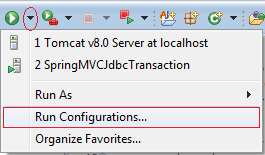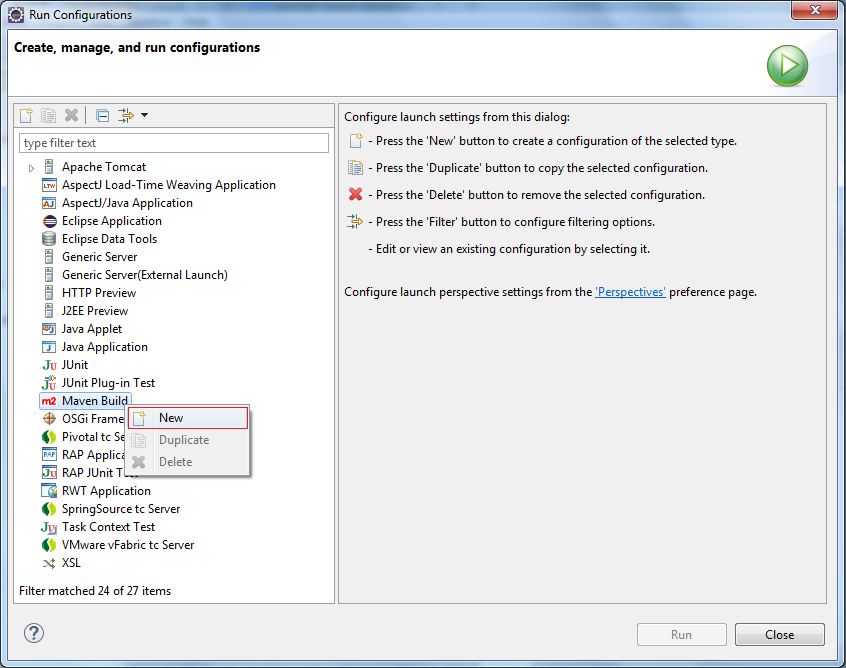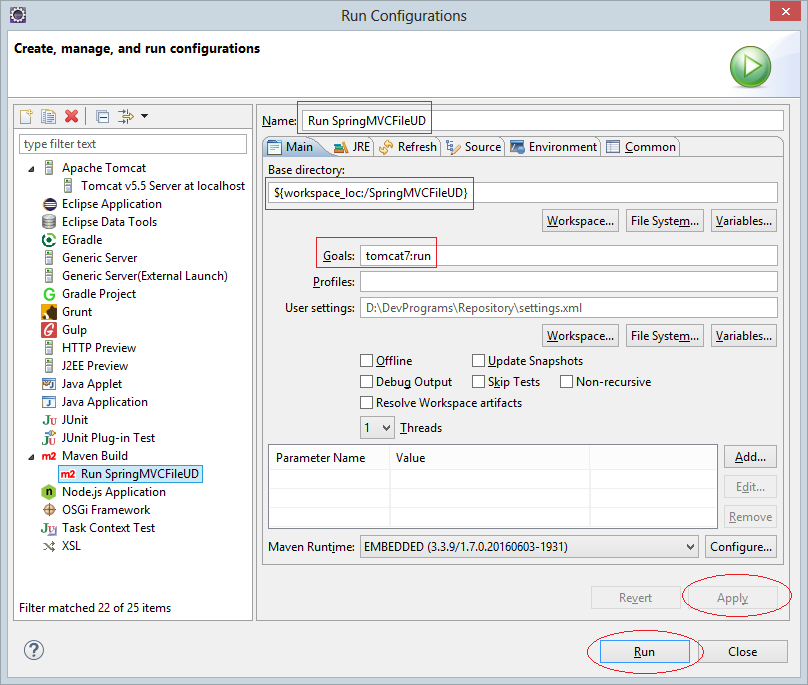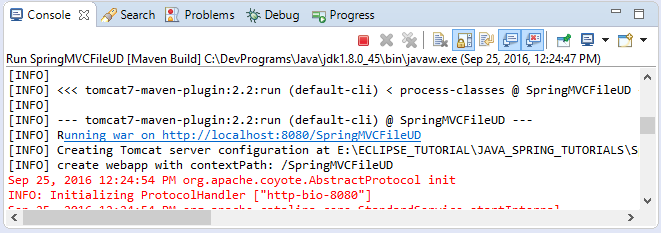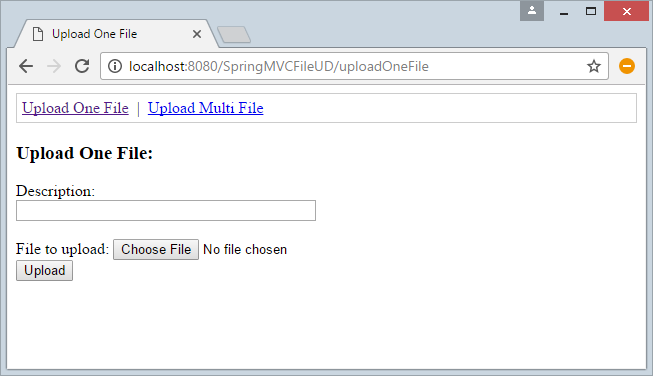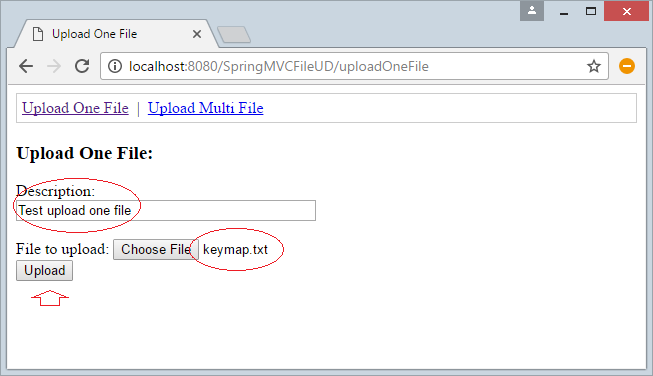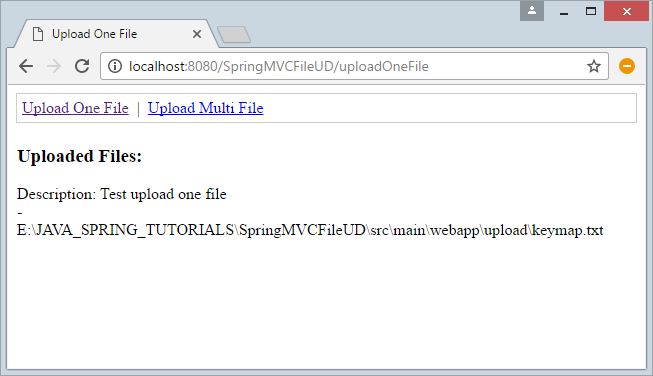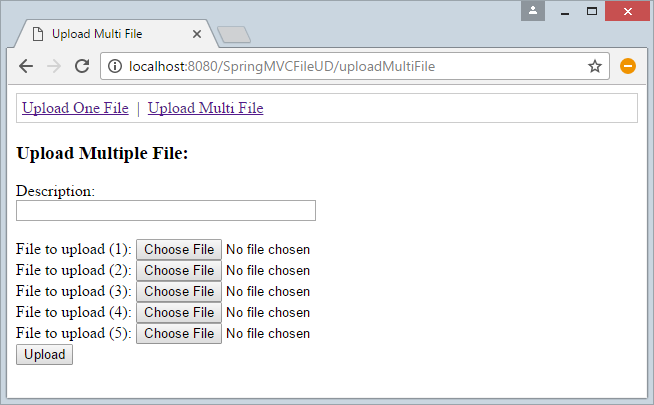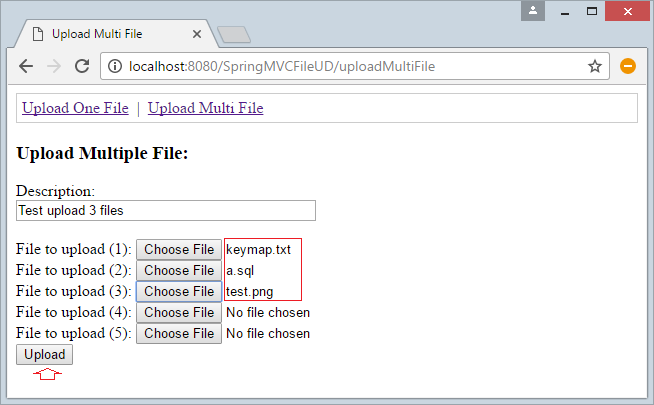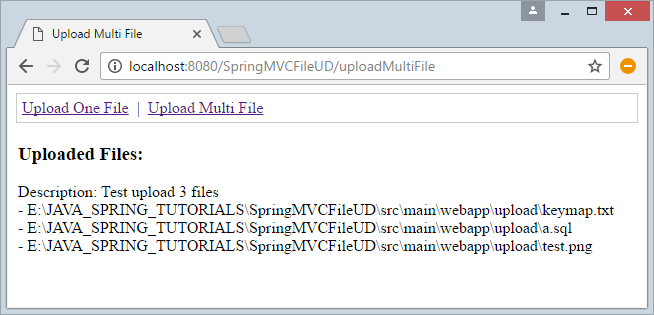Datei hochladen und herunterladen mit Spring MVC
1. Die Vorstellung
Der Unterlagen wird nach der ... geschrieben
- Eclipse 4.6 (NEON)
- Spring 4 MVC
See more:
2. Maven project erstellen
- File/New/Other..
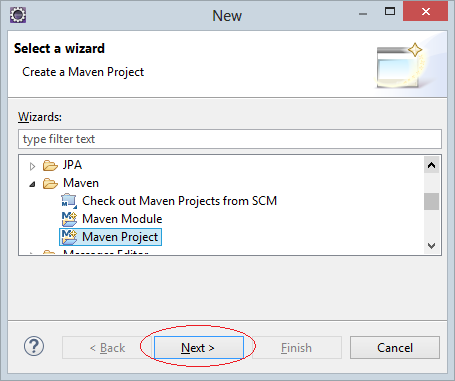

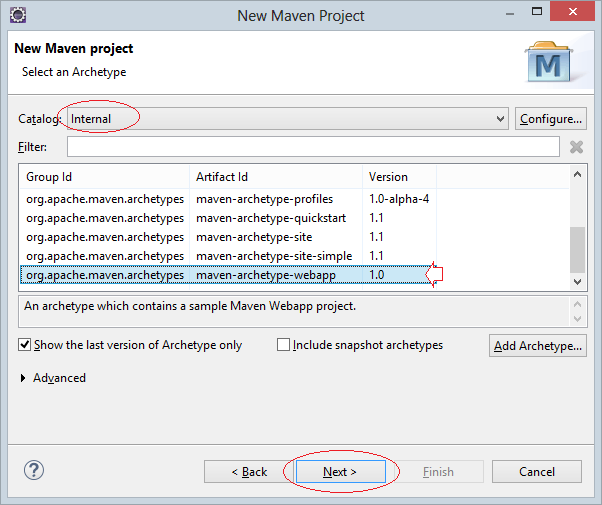
Geben Sie ein
- Group ID: org.o7planning
- Artifact ID: SpringMVCFileUD
- Package: org.o7planning.springmvcfileud
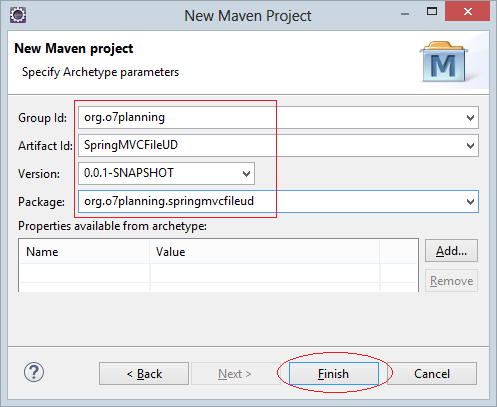
Ihr Projekt wird erstellt
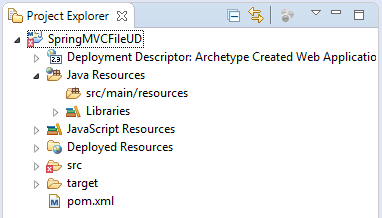
Sorgen Sie bitte nicht dafür, wenn das erstellte Projekt eine Fehleranmeldung erscheint. Der Grund liegt darin, dass die Bibliothek Servlet noch nicht erklärt wird
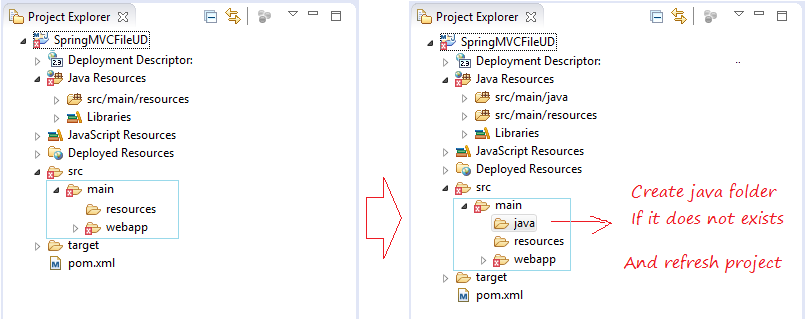
Java >= 6 benutzen
Project Properties:
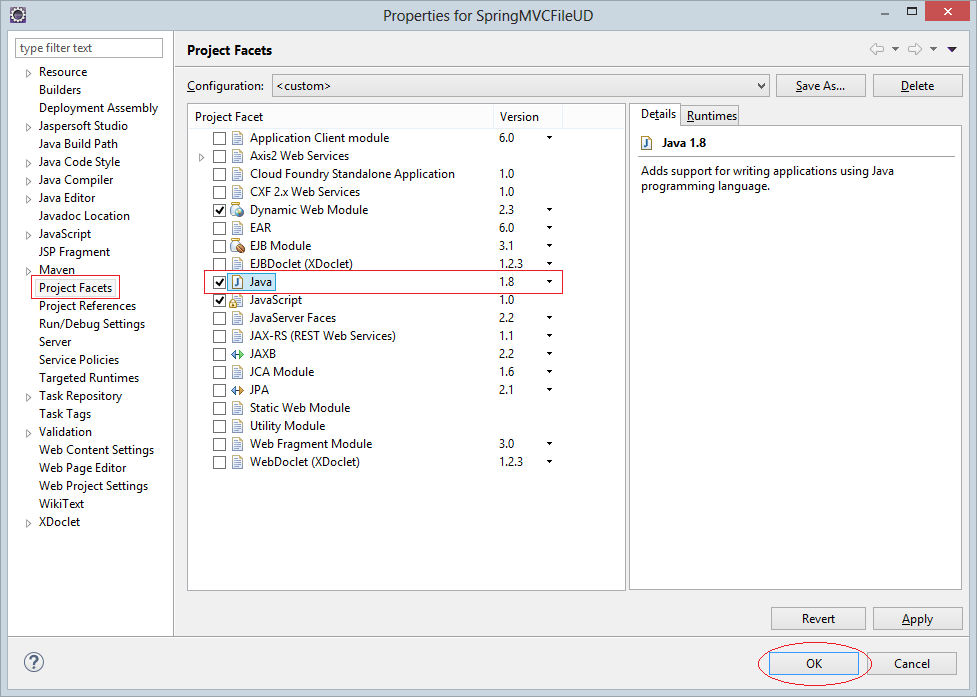
3. Maven & web.xml konfigurieren
Servlet API >= 3 benutzen
web.xml
<web-app xmlns="http://java.sun.com/xml/ns/javaee"
xmlns:xsi="http://www.w3.org/2001/XMLSchema-instance"
xsi:schemaLocation="http://java.sun.com/xml/ns/javaee
http://java.sun.com/xml/ns/javaee/web-app_3_0.xsd"
version="3.0">
<display-name>Spring MVC File Update Download</display-name>
</web-app>pom.xml
<project xmlns="http://maven.apache.org/POM/4.0.0"
xmlns:xsi="http://www.w3.org/2001/XMLSchema-instance"
xsi:schemaLocation="http://maven.apache.org/POM/4.0.0
http://maven.apache.org/maven-v4_0_0.xsd">
<modelVersion>4.0.0</modelVersion>
<groupId>org.o7planning</groupId>
<artifactId>SpringMVCFileUD</artifactId>
<packaging>war</packaging>
<version>0.0.1-SNAPSHOT</version>
<name>SpringMVCFileUD Maven Webapp</name>
<url>http://maven.apache.org</url>
<dependencies>
<dependency>
<groupId>junit</groupId>
<artifactId>junit</artifactId>
<version>3.8.1</version>
<scope>test</scope>
</dependency>
<!-- Servlet API -->
<!-- http://mvnrepository.com/artifact/javax.servlet/javax.servlet-api -->
<dependency>
<groupId>javax.servlet</groupId>
<artifactId>javax.servlet-api</artifactId>
<version>3.1.0</version>
<scope>provided</scope>
</dependency>
<!-- Jstl for jsp page -->
<!-- http://mvnrepository.com/artifact/javax.servlet/jstl -->
<dependency>
<groupId>javax.servlet</groupId>
<artifactId>jstl</artifactId>
<version>1.2</version>
</dependency>
<!-- JSP API -->
<!-- http://mvnrepository.com/artifact/javax.servlet.jsp/jsp-api -->
<dependency>
<groupId>javax.servlet.jsp</groupId>
<artifactId>jsp-api</artifactId>
<version>2.2</version>
<scope>provided</scope>
</dependency>
<!-- Spring dependencies -->
<!-- http://mvnrepository.com/artifact/org.springframework/spring-core -->
<dependency>
<groupId>org.springframework</groupId>
<artifactId>spring-core</artifactId>
<version>4.3.3.RELEASE</version>
</dependency>
<!-- http://mvnrepository.com/artifact/org.springframework/spring-web -->
<dependency>
<groupId>org.springframework</groupId>
<artifactId>spring-web</artifactId>
<version>4.3.3.RELEASE</version>
</dependency>
<!-- http://mvnrepository.com/artifact/org.springframework/spring-webmvc -->
<dependency>
<groupId>org.springframework</groupId>
<artifactId>spring-webmvc</artifactId>
<version>4.3.3.RELEASE</version>
</dependency>
<!-- Apache Commons FileUpload -->
<!-- http://mvnrepository.com/artifact/commons-fileupload/commons-fileupload -->
<dependency>
<groupId>commons-fileupload</groupId>
<artifactId>commons-fileupload</artifactId>
<version>1.3.1</version>
</dependency>
<!-- Apache Commons IO -->
<!-- http://mvnrepository.com/artifact/commons-io/commons-io -->
<dependency>
<groupId>commons-io</groupId>
<artifactId>commons-io</artifactId>
<version>2.4</version>
</dependency>
</dependencies>
<build>
<finalName>SpringMVCFileUD</finalName>
<plugins>
<!-- Config: Maven Tomcat Plugin -->
<!-- http://mvnrepository.com/artifact/org.apache.tomcat.maven/tomcat7-maven-plugin -->
<plugin>
<groupId>org.apache.tomcat.maven</groupId>
<artifactId>tomcat7-maven-plugin</artifactId>
<version>2.2</version>
<!-- Config: contextPath and Port (Default - /SpringMVCFileUD : 8080) -->
<!--
<configuration>
<path>/</path>
<port>8899</port>
</configuration>
-->
</plugin>
</plugins>
</build>
</project>4. Spring MVC konfigurieren
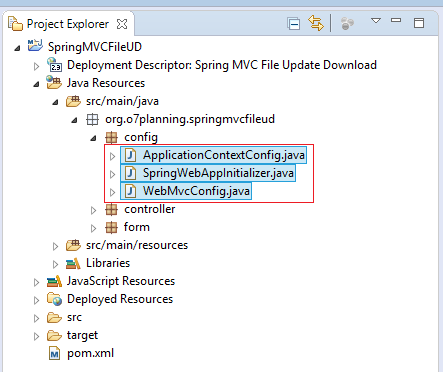
SpringWebAppInitializer.java
package org.o7planning.springmvcfileud.config;
import javax.servlet.FilterRegistration;
import javax.servlet.ServletContext;
import javax.servlet.ServletException;
import javax.servlet.ServletRegistration;
import org.springframework.web.WebApplicationInitializer;
import org.springframework.web.context.support.AnnotationConfigWebApplicationContext;
import org.springframework.web.filter.CharacterEncodingFilter;
import org.springframework.web.servlet.DispatcherServlet;
public class SpringWebAppInitializer implements WebApplicationInitializer {
@Override
public void onStartup(ServletContext servletContext) throws ServletException {
AnnotationConfigWebApplicationContext appContext = new AnnotationConfigWebApplicationContext();
appContext.register(ApplicationContextConfig.class);
ServletRegistration.Dynamic dispatcher = servletContext.addServlet("SpringDispatcher",
new DispatcherServlet(appContext));
dispatcher.setLoadOnStartup(1);
dispatcher.addMapping("/");
// UtF8 Charactor Filter.
FilterRegistration.Dynamic fr = servletContext.addFilter("encodingFilter", CharacterEncodingFilter.class);
fr.setInitParameter("encoding", "UTF-8");
fr.setInitParameter("forceEncoding", "true");
fr.addMappingForUrlPatterns(null, true, "/*");
}
}WebMvcConfig.java
package org.o7planning.springmvcfileud.config;
import org.springframework.context.annotation.Configuration;
import org.springframework.web.servlet.config.annotation.DefaultServletHandlerConfigurer;
import org.springframework.web.servlet.config.annotation.EnableWebMvc;
import org.springframework.web.servlet.config.annotation.ResourceHandlerRegistry;
import org.springframework.web.servlet.config.annotation.WebMvcConfigurerAdapter;
@Configuration
@EnableWebMvc
public class WebMvcConfig extends WebMvcConfigurerAdapter {
@Override
public void addResourceHandlers(ResourceHandlerRegistry registry) {
// Default..
}
@Override
public void configureDefaultServletHandling(DefaultServletHandlerConfigurer configurer) {
configurer.enable();
}
}Sie sollen multipartResolverSpring BEAN erklären. Im Spring Bean können Sie die maximale Kapazität der File konfigurieren.
ApplicationContextConfig.java
package org.o7planning.springmvcfileud.config;
import org.springframework.context.annotation.Bean;
import org.springframework.context.annotation.ComponentScan;
import org.springframework.context.annotation.Configuration;
import org.springframework.web.multipart.MultipartResolver;
import org.springframework.web.multipart.commons.CommonsMultipartResolver;
import org.springframework.web.servlet.view.InternalResourceViewResolver;
@Configuration
@ComponentScan("org.o7planning.springmvcfileud.*")
public class ApplicationContextConfig {
@Bean(name = "viewResolver")
public InternalResourceViewResolver getViewResolver() {
InternalResourceViewResolver viewResolver = new InternalResourceViewResolver();
viewResolver.setPrefix("/WEB-INF/pages/");
viewResolver.setSuffix(".jsp");
return viewResolver;
}
@Bean(name = "multipartResolver")
public MultipartResolver getMultipartResolver() {
CommonsMultipartResolver resover = new CommonsMultipartResolver();
// 1MB
resover.setMaxUploadSize(1 * 1024 * 1024);
return resover;
}
}5. Controllers & Form
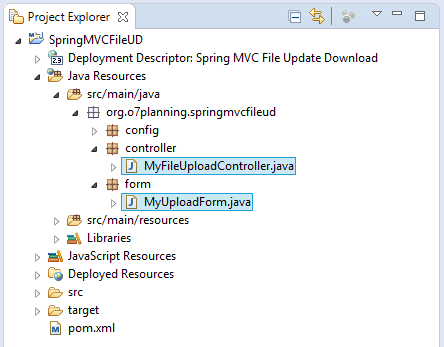
MyFileUploadController.java
package org.o7planning.springmvcfileud.controller;
import java.io.BufferedOutputStream;
import java.io.File;
import java.io.FileOutputStream;
import java.util.ArrayList;
import java.util.List;
import javax.servlet.http.HttpServletRequest;
import org.o7planning.springmvcfileud.form.MyUploadForm;
import org.springframework.stereotype.Controller;
import org.springframework.ui.Model;
import org.springframework.web.bind.WebDataBinder;
import org.springframework.web.bind.annotation.InitBinder;
import org.springframework.web.bind.annotation.ModelAttribute;
import org.springframework.web.bind.annotation.RequestMapping;
import org.springframework.web.bind.annotation.RequestMethod;
import org.springframework.web.multipart.commons.CommonsMultipartFile;
import org.springframework.web.multipart.support.ByteArrayMultipartFileEditor;
@Controller
public class MyFileUploadController {
@InitBinder
public void initBinder(WebDataBinder dataBinder) {
Object target = dataBinder.getTarget();
if (target == null) {
return;
}
System.out.println("Target=" + target);
if (target.getClass() == MyUploadForm.class) {
// Register to handle the conversion between the multipart object
// and byte array.
dataBinder.registerCustomEditor(byte[].class, new ByteArrayMultipartFileEditor());
}
}
// GET: Show upload form page.
@RequestMapping(value = "/uploadOneFile", method = RequestMethod.GET)
public String uploadOneFileHandler(Model model) {
MyUploadForm myUploadForm = new MyUploadForm();
model.addAttribute("myUploadForm", myUploadForm);
// Forward to "/WEB-INF/pages/uploadOneFile.jsp".
return "uploadOneFile";
}
// POST: Do Upload
@RequestMapping(value = "/uploadOneFile", method = RequestMethod.POST)
public String uploadOneFileHandlerPOST(HttpServletRequest request, //
Model model, //
@ModelAttribute("myUploadForm") MyUploadForm myUploadForm) {
return this.doUpload(request, model, myUploadForm);
}
// GET: Show upload form page.
@RequestMapping(value = "/uploadMultiFile", method = RequestMethod.GET)
public String uploadMultiFileHandler(Model model) {
MyUploadForm myUploadForm = new MyUploadForm();
model.addAttribute("myUploadForm", myUploadForm);
// Forward to "/WEB-INF/pages/uploadMultiFile.jsp".
return "uploadMultiFile";
}
// POST: Do Upload
@RequestMapping(value = "/uploadMultiFile", method = RequestMethod.POST)
public String uploadMultiFileHandlerPOST(HttpServletRequest request, //
Model model, //
@ModelAttribute("myUploadForm") MyUploadForm myUploadForm) {
return this.doUpload(request, model, myUploadForm);
}
private String doUpload(HttpServletRequest request, Model model, //
MyUploadForm myUploadForm) {
String description = myUploadForm.getDescription();
System.out.println("Description: " + description);
// Root Directory.
String uploadRootPath = request.getServletContext().getRealPath("upload");
System.out.println("uploadRootPath=" + uploadRootPath);
File uploadRootDir = new File(uploadRootPath);
//
// Create directory if it not exists.
if (!uploadRootDir.exists()) {
uploadRootDir.mkdirs();
}
CommonsMultipartFile[] fileDatas = myUploadForm.getFileDatas();
//
List<File> uploadedFiles = new ArrayList<File>();
for (CommonsMultipartFile fileData : fileDatas) {
// Client File Name
String name = fileData.getOriginalFilename();
System.out.println("Client File Name = " + name);
if (name != null && name.length() > 0) {
try {
// Create the file on server
File serverFile = new File(uploadRootDir.getAbsolutePath() + File.separator + name);
// Stream to write data to file in server.
BufferedOutputStream stream = new BufferedOutputStream(new FileOutputStream(serverFile));
stream.write(fileData.getBytes());
stream.close();
//
uploadedFiles.add(serverFile);
System.out.println("Write file: " + serverFile);
} catch (Exception e) {
System.out.println("Error Write file: " + name);
}
}
}
model.addAttribute("description", description);
model.addAttribute("uploadedFiles", uploadedFiles);
return "uploadResult";
}
}MyUploadForm.java
package org.o7planning.springmvcfileud.form;
import org.springframework.web.multipart.commons.CommonsMultipartFile;
public class MyUploadForm {
private String description;
// Upload files.
private CommonsMultipartFile[] fileDatas;
public String getDescription() {
return description;
}
public void setDescription(String description) {
this.description = description;
}
public CommonsMultipartFile[] getFileDatas() {
return fileDatas;
}
public void setFileDatas(CommonsMultipartFile[] fileDatas) {
this.fileDatas = fileDatas;
}
}6. Views
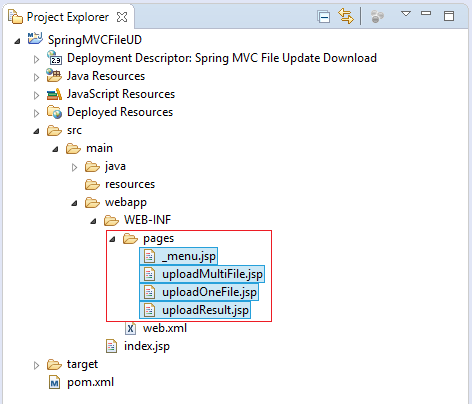
_menu.jsp
<%@taglib uri="http://www.springframework.org/tags/form" prefix="form"%>
<div style="border:1px solid #ccc;padding:5px;">
<a href="${pageContext.request.contextPath}/uploadOneFile">Upload One File</a>
|
<a href="${pageContext.request.contextPath}/uploadMultiFile">Upload Multi File</a>
</div>Beachten Sie: Auf form brauchen Sie das Attribut enctype="multipart/form-data" um die Daten hochzuladen
uploadOneFile.jsp
<%@taglib uri="http://www.springframework.org/tags/form" prefix="form"%>
<html>
<head>
<meta http-equiv="Content-Type" content="text/html; charset=UTF-8">
<title>Upload One File</title>
</head>
<body>
<jsp:include page="_menu.jsp"/>
<h3>Upload One File:</h3>
<!-- MyUploadForm -->
<form:form modelAttribute="myUploadForm" method="POST"
action="" enctype="multipart/form-data">
Description:
<br>
<form:input path="description" style="width:300px;"/>
<br/><br/>
File to upload: <form:input path="fileDatas" type="file"/><br />
<input type="submit" value="Upload">
</form:form>
</body>
</html>uploadMultiFile.jsp
<%@taglib uri="http://www.springframework.org/tags/form" prefix="form"%>
<html>
<head>
<meta http-equiv="Content-Type" content="text/html; charset=UTF-8">
<title>Upload Multi File</title>
</head>
<body>
<jsp:include page="_menu.jsp"/>
<h3>Upload Multiple File:</h3>
<!-- MyUploadForm -->
<form:form modelAttribute="myUploadForm" method="POST"
action="" enctype="multipart/form-data">
Description:
<br>
<form:input path="description" style="width:300px;"/>
<br/><br/>
File to upload (1): <form:input path="fileDatas" type="file"/><br />
File to upload (2): <form:input path="fileDatas" type="file"/><br />
File to upload (3): <form:input path="fileDatas" type="file"/><br />
File to upload (4): <form:input path="fileDatas" type="file"/><br />
File to upload (5): <form:input path="fileDatas" type="file"/><br />
<input type="submit" value="Upload">
</form:form>
</body>
</html>uploadResult.jsp
<%@taglib uri="http://java.sun.com/jsp/jstl/core" prefix="c"%>
<html>
<head>
<meta charset="UTF-8">
<title>Upload Result</title>
</head>
<body>
<jsp:include page="_menu.jsp"/>
<h3>Uploaded Files:</h3>
Description: ${description}
<br/>
<c:forEach items="${uploadedFiles}" var="file">
- ${file} <br>
</c:forEach>
</body>
</html>Anleitungen Spring MVC
- Die Anleitung zum Sping für den Anfänger
- Installieren Sie die Spring Tool Suite für Eclipse
- Die Anleitung zum Sping MVC für den Anfänger - Hello Spring 4 MVC
- Konfigurieren Sie statische Ressourcen in Spring MVC
- Die Anleitung zu Spring MVC Interceptor
- Erstellen Sie eine mehr Sprachen Web-Anwendung mit Spring MVC
- Datei hochladen und herunterladen mit Spring MVC
- Einfache Anmeldung Java Web Application mit Spring MVC, Spring Security und Spring JDBC
- Social Login in Spring MVC mit Spring Social Security
- Die Anleitung zu Spring MVC mit FreeMarker
- Verwenden Sie Template in Spring MVC mit Apache Tiles
- Hướng dẫn sử dụng Spring MVC và Spring JDBC Transaction
- Verwenden Sie in Spring MVC mehrere DataSources
- Die Anleitung zu Spring MVC Form und Hibernate
- Führen Sie geplante Hintergrundaufgaben in Spring aus
- Erstellen Sie eine Java Shopping Cart Web Application mit Spring MVC und Hibernate
- Einfache CRUD Beispiel mit Spring MVC RESTful Web Service
- Stellen Sie Spring MVC auf Oracle WebLogic Server bereit
Show More
